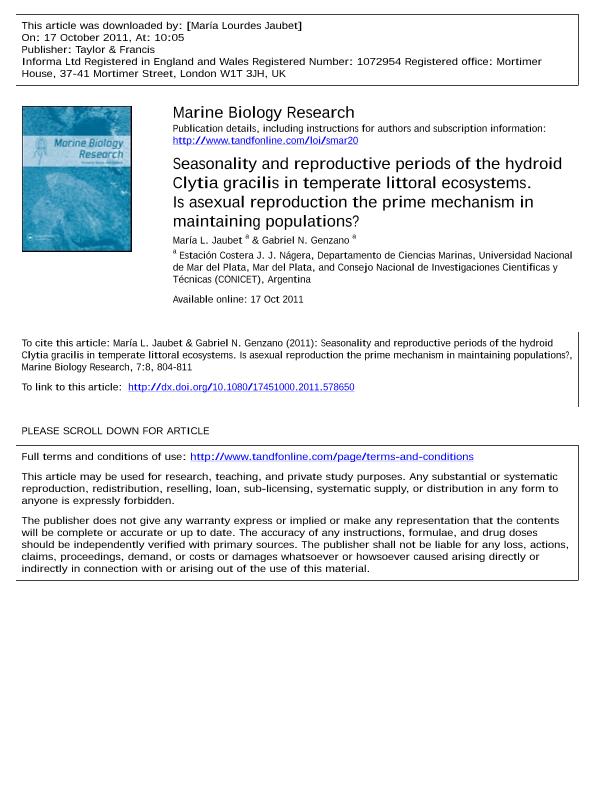Artículo
Seasonality and reproductive periods of the hydroid Clytia gracilis in temperate littoral ecosystems. Is asexual reproduction the prime mechanism in maintaining populations?
Fecha de publicación:
11/2011
Editorial:
Taylor & Francis
Revista:
Marine Biology Research
ISSN:
1745-1000
Idioma:
Inglés
Tipo de recurso:
Artículo publicado
Clasificación temática:
Resumen
Hydropolyps inhabiting temperate ecosystems exhibit marked seasonality, and undergo regression as a normal part of their life cycle. In the campanulariid species Clytia gracilis, both hydroids and medusae are decidedly seasonal in occurrence. Epizoic colonies of C. gracilis, growing on colonies of Ectopleura crocea, were collected monthly in the intertidal zone at Mar del Plata, Argentina (38°08′S-57°37′W) during low tide from February 2000 to January 2001. Abundance, seasonality and reproductive periods were analysed. The hydroid reached peak abundance during the summer, yet reproductive structures were scarce and observed in only a few colonies. A remarkable regression period was evident in the cold season. During that period, hydroids of the species had few functional polyps, and the colonies were largely reduced to dormant tissue in the coenosarc of hydrocauli and stolons. Hydranths of C. gracilis regenerated during summer and produced a profuse asexual growth by stolonization. Asexual propagation is proposed as the prime mechanism in maintaining these hydroid populations. In comparisons of intertidal and subtidal populations of C. gracilis, available hydroid colonies of Amphisbetia operculata and Plumularia setacea collected from neighboring rocky outcrops (38°10′S-57°30′W), at depths of 18-20 m, during both warm and cold seasons were analysed. As in the intertidal populations, these colonies showed marked stolonal growth at the end of summer.
Palabras clave:
ASEXUAL PROPAGATION
,
CLYTIA GRACILIS
,
HYDROIDS
,
HYDROMEDUSAE
,
SEASONALITY
Archivos asociados
Licencia
Identificadores
Colecciones
Articulos(CCT - MAR DEL PLATA)
Articulos de CTRO.CIENTIFICO TECNOL.CONICET - MAR DEL PLATA
Articulos de CTRO.CIENTIFICO TECNOL.CONICET - MAR DEL PLATA
Articulos(IIMYC)
Articulos de INSTITUTO DE INVESTIGACIONES MARINAS Y COSTERAS
Articulos de INSTITUTO DE INVESTIGACIONES MARINAS Y COSTERAS
Citación
Jaubet, Maria Lourdes; Genzano, Gabriel Nestor; Seasonality and reproductive periods of the hydroid Clytia gracilis in temperate littoral ecosystems. Is asexual reproduction the prime mechanism in maintaining populations?; Taylor & Francis; Marine Biology Research; 7; 8; 11-2011; 804-811
Compartir
Altmétricas




